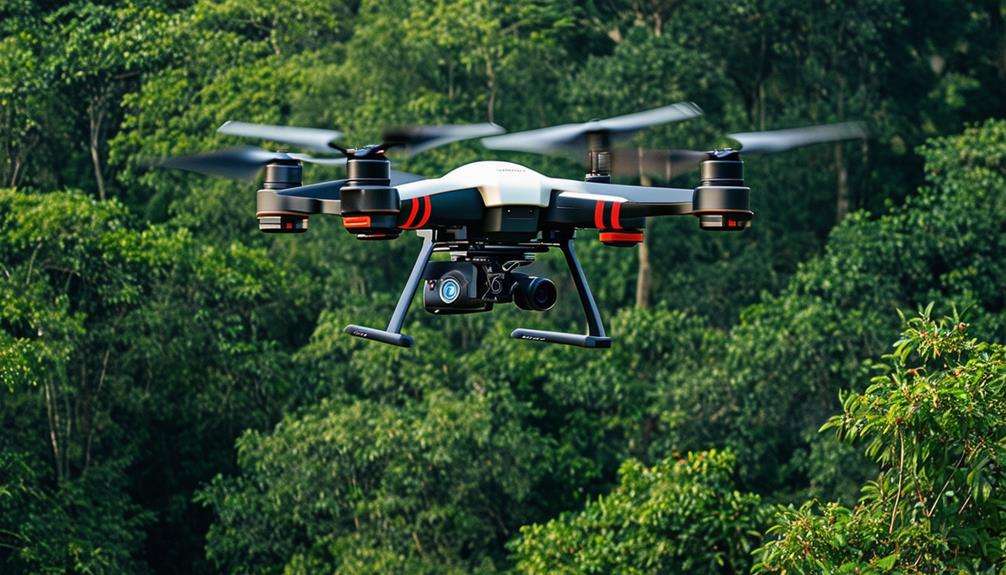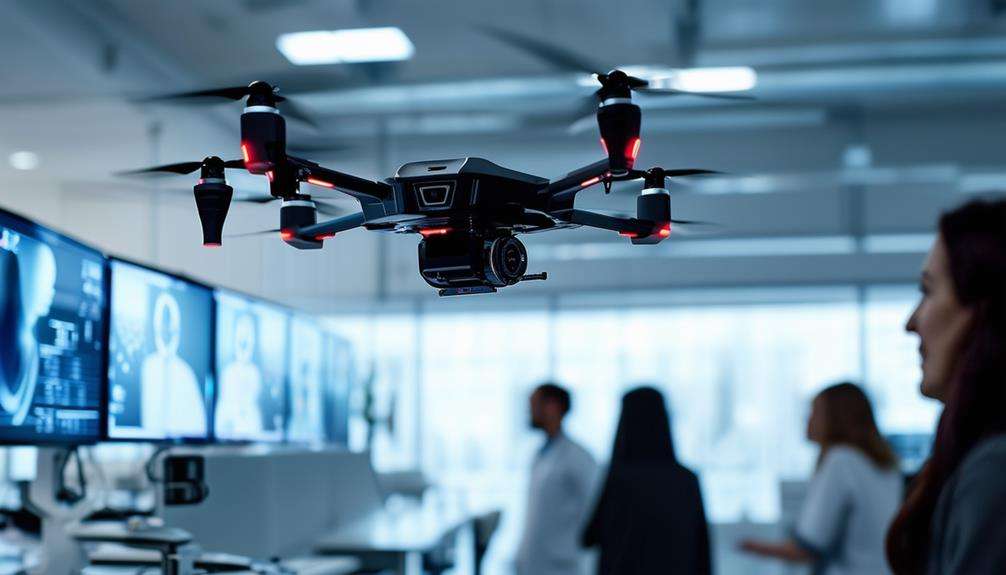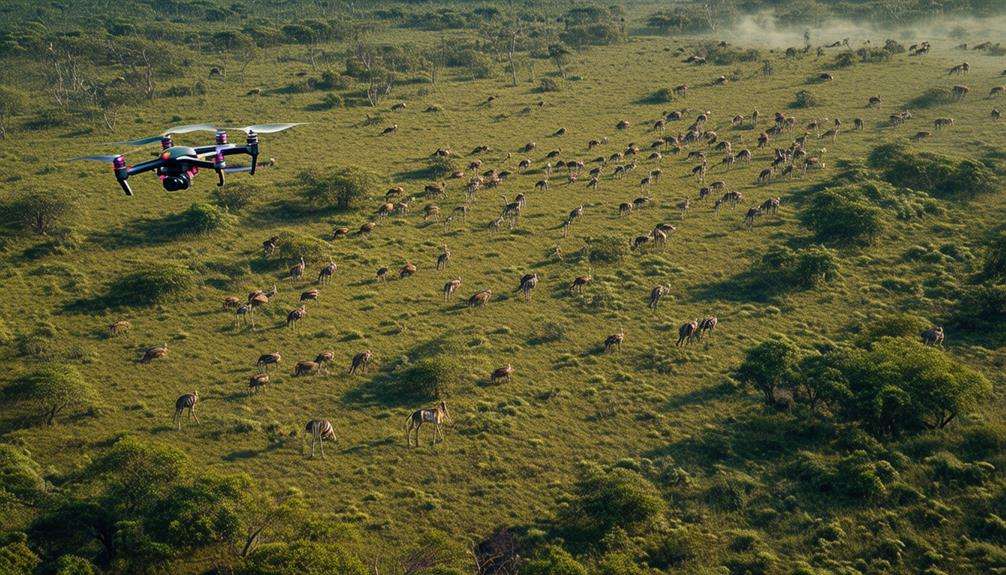Do Any Companies Use Drones for Delivery?
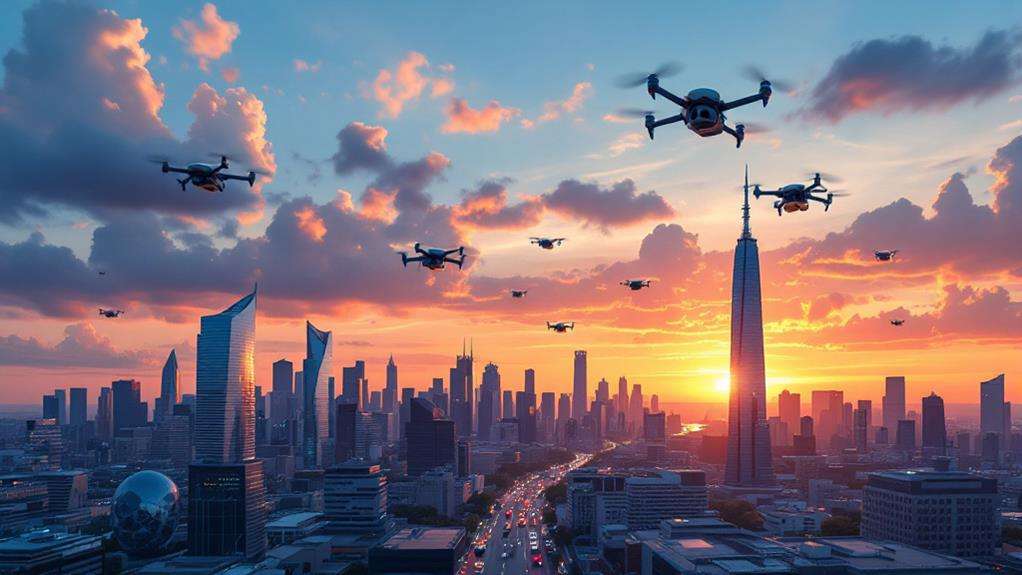
Yes, several companies are using drones for delivery today. Amazon Prime Air offers fast deliveries in Texas, while UPS Flight Forward focuses on transporting medical supplies, being the first to receive FAA certification for this purpose. Walmart has also entered the scene, completing thousands of deliveries in the Dallas Fort Worth area. Zipline excels in healthcare logistics, having delivered over a million supplies, partly due to partnerships like OhioHealth. These drones aren't just about speed and efficiency; they revolutionize the delivery process, with promising benefits for the future. Continue to discover how they transform industries and daily life.
Key Takeaways
- Amazon Prime Air operates drone deliveries in Texas, offering package delivery within 30 minutes.
- UPS Flight Forward specializes in drone delivery of medical supplies, holding FAA certification.
- Walmart has completed over 6,000 drone deliveries, serving 1.8 million customers in the Dallas Fort Worth area.
- Zipline has achieved over one million drone deliveries, focusing on healthcare logistics.
- Partnerships among companies enhance operational capabilities and broaden market reach for drone deliveries.
Overview of Drone Delivery
In today's fast-paced world, drone delivery is rapidly transforming how goods reach consumers, making the process quicker and more efficient. You'll find that companies like Amazon Prime Air and UPS Flight Forward are leading the way in revolutionizing delivery services. These autonomous drones are not just futuristic gadgets; they're becoming essential tools in meeting the growing consumer demand for swift delivery. Notably, drone mail delivery offers a greener solution for last-mile deliveries, reducing carbon emissions and supporting sustainable practices within postal services. The global drone delivery market is set to soar, projected to surpass $33 million by 2033, with an explosive growth to $29 billion by 2027. This boom is largely fueled by the convenience and speed drones bring to commercial operations. The FAA's regulatory advancements, particularly in allowing beyond visual line of sight operations, have paved the way for scaling these services across the U.S.
Drones are proving invaluable in specialized sectors, too. Companies like Zipline have successfully delivered over one million medical supplies, showcasing the critical role drone logistics play in healthcare. As these autonomous drones become more integrated into delivery services, you'll witness a significant shift in how goods are distributed globally, ensuring that quick and efficient delivery becomes the norm rather than the exception.
Major Players in the Industry
As drone delivery reshapes the logistics landscape, several key players are at the forefront of this innovation. Amazon Prime Air has been a pioneering drone delivery company since 2016. They currently operate in College Station, Texas, and have plans for further expansion, thanks to FAA certification that allows them to conduct BVLOS (Beyond Visual Line of Sight) operations. This step forward enables Amazon to integrate delivery drones effectively into its logistics. Additionally, the environmental benefits of drone deliveries, such as reduced pollution and lower carbon emissions compared to traditional vehicles, align with Amazon's sustainability goals. UPS Flight Forward became the first company to receive FAA certification for drone deliveries in 2021. Their focus is on integrating drones into existing logistics networks, particularly for medical supply deliveries, in partnership with Matternet. This strategic move highlights their commitment to enhancing healthcare logistics. Walmart, in collaboration with partners like Flytrex, DroneUp, and Zipline, completed over 6,000 deliveries in 2022. They're expanding their service to 1.8 million customers in the Dallas Fort Worth area, partnering with Google's Wing, known for launching the first commercial drone delivery in a U.S. metro area. Zipline stands out in medical supply deliveries, reaching a milestone of one million deliveries by April 2024, proving the potential of delivery drones in healthcare logistics.
Regulatory Challenges
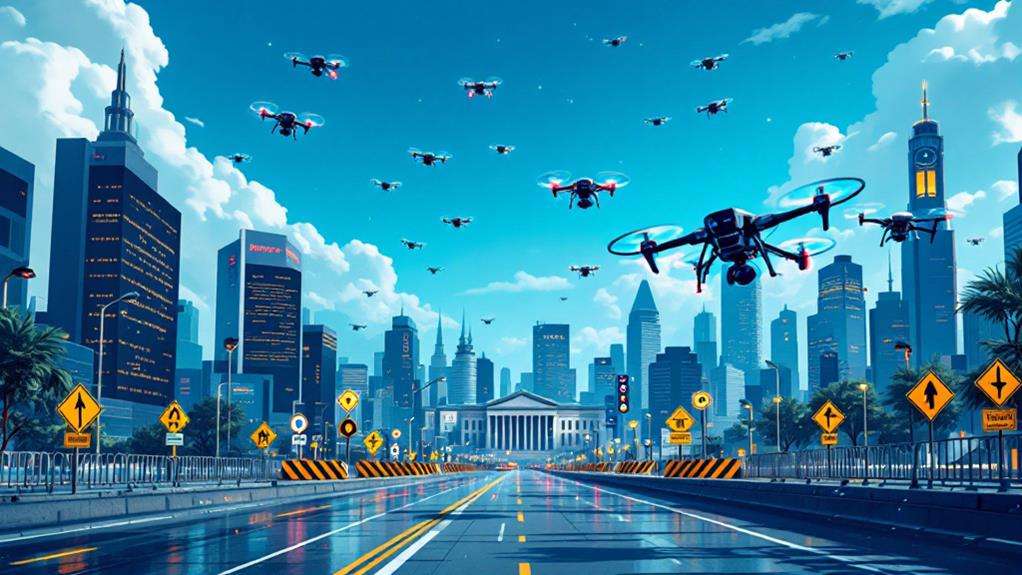
Navigating the regulatory labyrinth poses a substantial challenge for the drone delivery industry. The complexity of laws at local, state, and federal levels leads to significant compliance difficulties, hindering the expansion of drone deliveries. The Federal Aviation Administration (FAA) plays a pivotal role, with Part 107 regulations restricting air carrier operations unless remote pilots command the drones. This restriction complicates the logistics of delivery operations, making it tough for companies to proceed without securing necessary operational approvals.
To conduct Beyond Visual Line of Sight (BVLOS) operations, companies must obtain a Section 44807 exemption from the FAA. This process involves extensive paperwork and can be both time-consuming and exhausting. Moreover, local governments add another layer of complexity by imposing varying terminology and regulations on drone operations, creating additional hurdles for companies striving to maintain compliance.
Here's a quick breakdown:
| Regulatory Aspect | Challenge | Impact on Operations |
|---|---|---|
| FAA Part 107 | Requires remote pilots | Complicates logistics |
| BVLOS Exemption | Extensive paperwork | Time-consuming process |
| Local Regulations | Diverse terminology | Increased compliance effort |
Strategic Approaches
While regulatory challenges loom large, the drone delivery industry is taking strategic steps to overcome them and drive growth. In the burgeoning drone delivery market, major players like Amazon, Walmart, and UPS are adopting distinct strategies to carve out their niches. Amazon's strategy is all about control. By managing the entire technology stack and customer experience, Amazon aims to expand its Prime Air service, using its comprehensive supply chain for a competitive advantage. This approach helps it streamline delivery services and enhance operational capabilities.
Walmart, on the other hand, uses a multi-partner strategy. By collaborating with companies like Flytrex, DroneUp, and Zipline, Walmart has already completed over 6,000 deliveries in 2022. This approach allows Walmart to optimize service across diverse regions, enhancing its reach and efficiency. Meanwhile, UPS has partnered with Matternet, leveraging FAA certifications to secure Part 135 Operational Approval for drone deliveries. This strategic move not only strengthens its operational capabilities but also positions UPS to possibly integrate drone delivery with next-gen trucking solutions.
As the drone delivery market matures, competition among these Drone Delivery Companies is expected to intensify, with each company refining its strategic approach to dominate the skies.
Technological Innovations
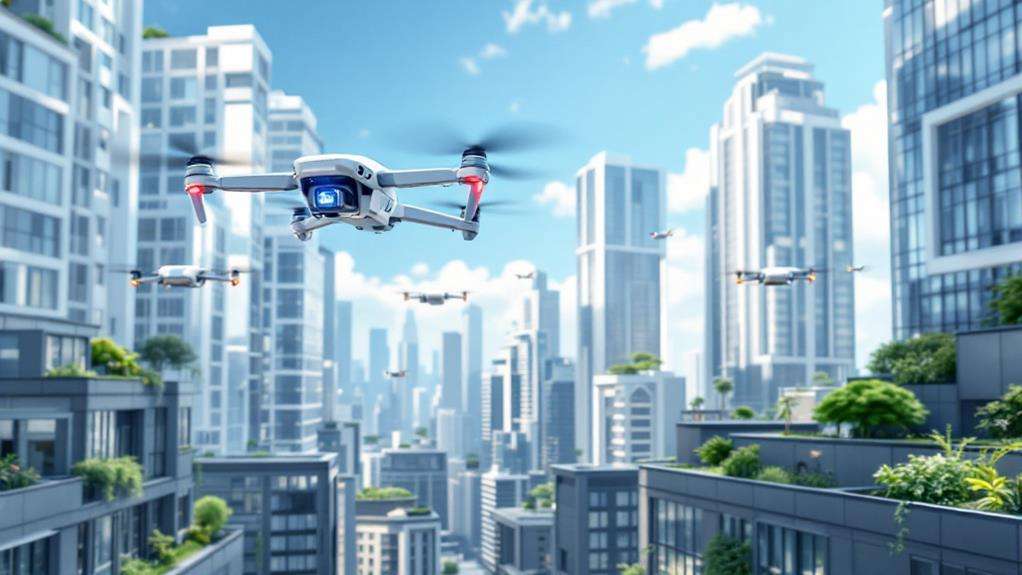
Technological innovations are revolutionizing the drone delivery industry, making it more efficient and reliable. Thanks to advancements in drone technology, unmanned aerial vehicles are now more capable of handling commercial deliveries. Advanced navigation systems using GPS and AI allow these drones to operate autonomously, enhancing their delivery precision. With these systems, drones can efficiently find their way through complex urban landscapes, significantly improving delivery times and reducing the risk of errors.
Enhanced battery technology is another critical advancement, extending flight durations and allowing drones to travel greater distances without needing frequent recharges. This means deliveries can cover larger areas, reaching more customers without interruption. Moreover, collision avoidance systems ensure safe operation by detecting and avoiding obstacles, crucial in crowded environments where the risk of accidents is higher.
Secure delivery tracking has also seen improvements with the integration of blockchain technology, offering transparency and reliability. This technology ensures that packages are tracked accurately, maintaining trust in the delivery process. Companies are also exploring the potential of hybrid drones, which merge fixed-wing and multirotor capabilities, optimizing them for varied delivery scenarios. To achieve operational approval, these technological advancements must meet rigorous safety and efficiency standards, paving the way for a future of seamless drone deliveries.
Consumer Benefits
As drone technology advances, consumers stand to gain significant benefits from these innovations in delivery services. Imagine ordering your favorite product and having it delivered via drone within 30 minutes. This rapid response transforms your customer experience, drastically reducing delivery times compared to traditional delivery methods. Whether you're in a bustling city or a remote location, drone deliveries ensure you receive your goods quickly and efficiently.
One of the biggest advantages is the reduced delivery costs. Some services offer delivery fees as low as $4.00, making drone deliveries an affordable option. This cost efficiency allows you greater access to products, expanding your choices beyond what local stores might offer. For example, in the Dallas Fort Worth area, you could have access to up to 80% of Walmart products within a 10-mile radius.
Moreover, drones offer a sustainable delivery option. They help decrease traffic congestion and reduce carbon emissions, making them an attractive choice for environmentally-conscious consumers. Unlike traditional delivery methods, drones provide a cleaner, more efficient way to get goods to your doorstep. Overall, drone deliveries promise a revolutionized shopping experience that's fast, affordable, and eco-friendly.
Economic Impact
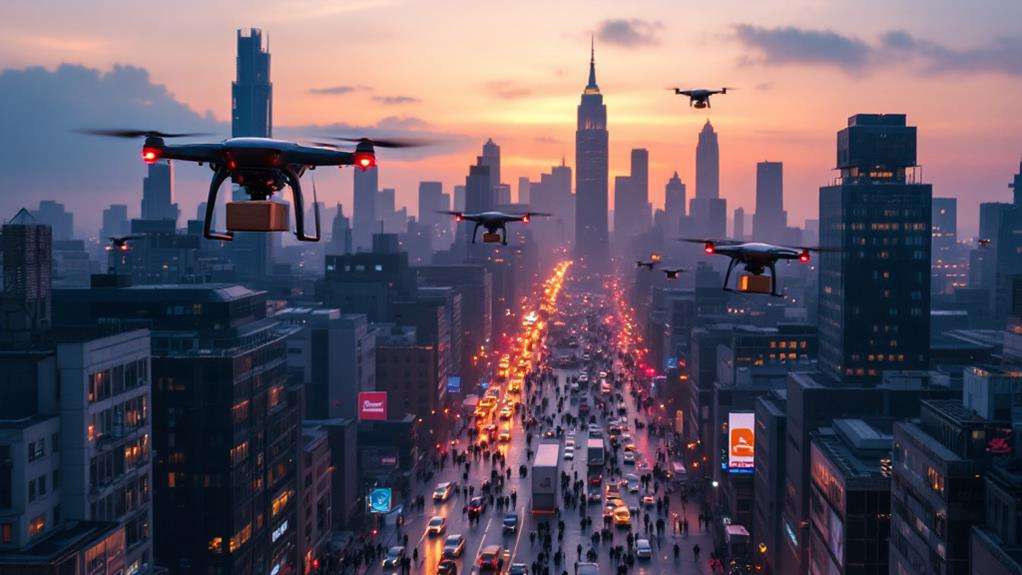
Propelling the logistics industry into a new era, drone delivery is set to reshape economic landscapes worldwide. With the global drone delivery market projected to reach $9.51 billion by 2027, drone deliveries are a game-changer for businesses looking to cut operational costs and improve package delivery efficiency. By minimizing delivery costs to as low as $1.00 per package, drones offer a competitive edge over traditional methods. As consumer demand for faster delivery options grows, investing in drone technology becomes increasingly appealing, promising significant economic benefits.
Integrating drones into logistics not only enhances efficiency but also transforms supply chain performance. Drones can bypass traffic congestion, reducing delivery times and ensuring timely package delivery. This heightened efficiency is pivotal in meeting the ever-increasing consumer demand for rapid logistics solutions.
| Aspect | Traditional Methods | Drone Deliveries |
|---|---|---|
| Operational Costs | Higher | Lower |
| Delivery Times | Longer | Shorter |
| Supply Chain Performance | Standard | Enhanced |
However, while drones create new job opportunities in drone technology and logistics, they might also displace some traditional delivery roles, impacting the labor market. Balancing these changes is key to harnessing the full economic potential of drone deliveries.
Case Studies
Examining real-life implementations of drone deliveries reveals their transformative impact on logistics. Amazon Prime Air, operational since August 2020, uses small drones to transport packages up to 5 pounds within 30 minutes. Their trials in Lockeford, California, highlight the potential of commercial drone delivery to revolutionize last-mile logistics.
UPS Flight Forward, a pioneer in this space, became the first company to receive FAA certification for drone deliveries in 2021. Their focus on integrating drones into existing networks has streamlined delivery operations, especially for medical supplies, demonstrating the efficiency of drone logistics in critical scenarios.
Zipline, renowned for its achievements in medical supply logistics, marked its one-millionth delivery in April 2024. Partnering with OhioHealth, they've ensured critical medical deliveries reach those in need swiftly, showcasing drones' vital role in healthcare logistics.
Meanwhile, Walmart has expanded its drone delivery services, partnering with multiple providers to complete over 6,000 deliveries in 2022. Their operations, particularly in the Dallas Fort Worth area, serve over 1.8 million customers with a 10-mile delivery radius, underscoring the scalability and efficiency of drone deliveries in retail. These case studies illustrate the growing importance and potential of drones in modern logistics.


